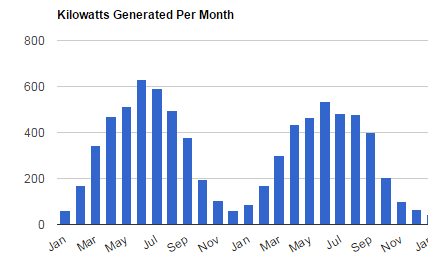I have had a chance to tally up the results from my second year of solar panel power production. When I purchased the solar panels in 2015, I had estimated a six year payback based on estimated production, and on the subsidies payed on power generated. For 2016, I generated 3.45 megawatts, which was down 13% from 2015:

I am assuming the two primary factors for the production drop off is 2015 was a exceedingly sunny year make it hard to match, along with the gradual drop off in efficiency of the panels over time. I will be surprised if following years show the same level of dropoff. Interesting, this year showed better production numbers for the last 5 months of the year vs 2015, so that gives me hope that its not a panel issue.
In my payback analysis I had budgeted $2,098 of revenue a year, and my check for 2016 came in at $1,853. So early on it looks like 6 years might be optimistic. The other danger to the 6 year payback is the possible lowering of incentives on home power generation. The money available always seems to be at risk, but it appears possible that incentives will be less then originally estimated. House Bill 1048 was introduced to finalize the incentives (see bill summary here) so a lot will depend on if this passes this year. Interestingly, this bill does include incentives past 2020, which I did not include in my payback analysis, so that is a plus.
The maintenance of the panels has been a pleasant surprise, an occasional hosing off of the panels from ground level, and once or twice a year I get up on the roof and wash and squeegy them. In the spring the pollen was pretty dense on the panels, and I did notice an increase in production after a cleaning.
On a related power note, while I was out checking power meters, I checked my usage meter and my usage was 8.4 megawatts, up 4% for the year. This surprised me a bit – since in 2015 we ran more air conditioning and in 2016 I replaced a number of lights with LEDs. However, I will attribute the increase in usage to the additional time I spent working from home in 2016, thus leaving more lights and heat on (maybe the refridgerator door being opened more often?). Anyway, I am targeting a reduction in usage for 2017.
In summary, I am still pleased with the investment, and am now shooting for a 7-8 year payback which still isn’t too bad. Solar panel prices continue to drop, and when I get around to needing to replace my roof the solar shingles look like they might be ready. So I plan to be in the power business for many years to come.
